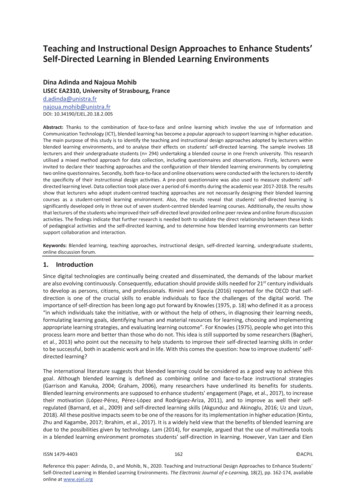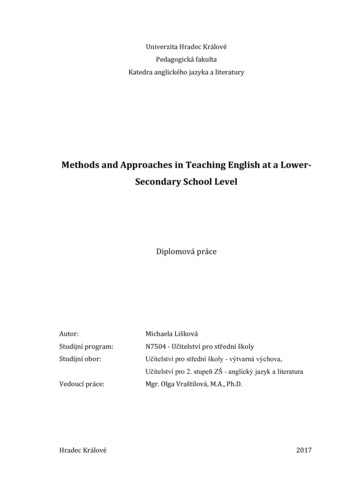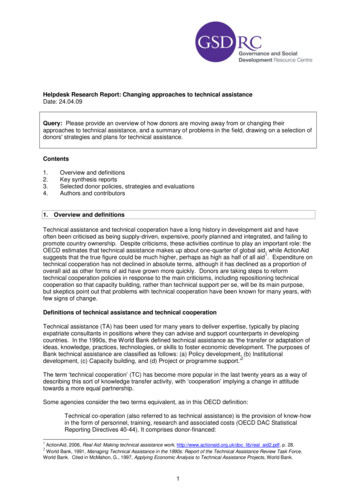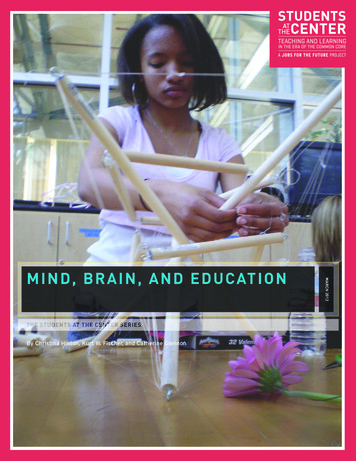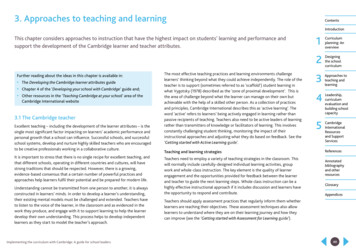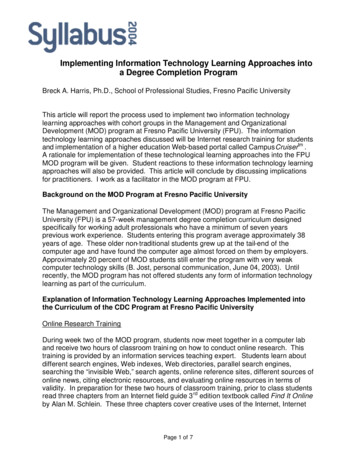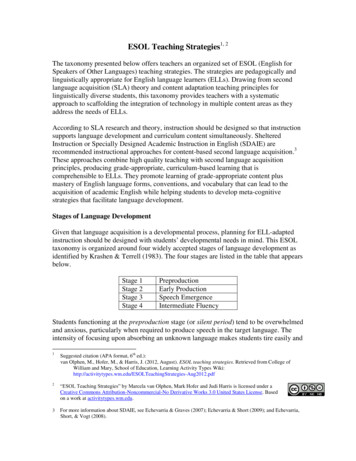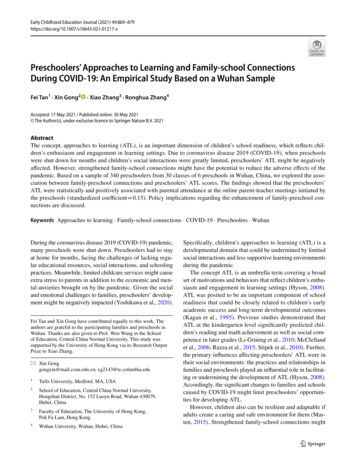
Transcription
Early Childhood Education Journal (2021) 17-xPreschoolers’ Approaches to Learning and Family‑school ConnectionsDuring COVID‑19: An Empirical Study Based on a Wuhan SampleFei Tan1 · Xin Gong2· Xiao Zhang3 · Ronghua Zhang4Accepted: 17 May 2021 / Published online: 30 May 2021 The Author(s), under exclusive licence to Springer Nature B.V. 2021AbstractThe concept, approaches to learning (ATL), is an important dimension of children’s school readiness, which reflects children’s enthusiasm and engagement in learning settings. Due to coronavirus disease 2019 (COVID-19), when preschoolswere shut down for months and children’s social interactions were greatly limited, preschoolers’ ATL might be negativelyaffected. However, strengthened family-school connections might have the potential to reduce the adverse effects of thepandemic. Based on a sample of 340 preschoolers from 30 classes of 6 preschools in Wuhan, China, we explored the association between family-preschool connections and preschoolers’ ATL scores. The findings showed that the preschoolers’ATL were statistically and positively associated with parental attendance at the online parent-teacher meetings initiated bythe preschools (standardized coefficient 0.15). Policy implications regarding the enhancement of family-preschool connections are discussed.Keywords Approaches to learning · Family-school connections · COVID-19 · Preschoolers · WuhanDuring the coronavirus disease 2019 (COVID-19) pandemic,many preschools were shut down. Preschoolers had to stayat home for months, facing the challenges of lacking regular educational resources, social interactions, and schoolingpractices. Meanwhile, limited childcare services might causeextra stress to parents in addition to the economic and mental anxieties brought on by the pandemic. Given the socialand emotional challenges to families, preschoolers’ development might be negatively impacted (Yoshikawa et al., 2020).Fei Tan and Xin Gong have contributed equally to this work. Theauthors are grateful to the participating families and preschools inWuhan. Thanks are also given to Prof. Wen Wang in the Schoolof Education, Central China Normal University. This study wassupported by the University of Hong Kong via its Research OutputPrize to Xiao Zhang.* Xin Gonggongxin@mail.ccnu.edu.cn; xg2143@tc.columbia.edu1Tufts University, Medford, MA, USA2School of Education, Central China Normal University,Hongshan District, No. 152 Luoyu Road, Wuhan 430079,Hubei, China3Faculty of Education, The University of Hong Kong,Pok Fu Lam, Hong Kong4Wuhan University, Wuhan, Hubei, ChinaSpecifically, children’s approaches to learning (ATL) is adevelopmental domain that could be undermined by limitedsocial interactions and less supportive learning environmentsduring the pandemic.The concept ATL is an umbrella term covering a broadset of motivations and behaviors that reflect children’s enthusiasm and engagement in learning settings (Hyson, 2008).ATL was posited to be an important component of schoolreadiness that could be closely related to children’s earlyacademic success and long-term developmental outcomes(Kagan et al., 1995). Previous studies demonstrated thatATL at the kindergarten level significantly predicted children’s reading and math achievement as well as social competence in later grades (Li-Grining et al., 2010; McClellandet al., 2006; Razza et al., 2015; Stipek et al., 2010). Further,the primary influences affecting preschoolers’ ATL were intheir social environments: the practices and relationships infamilies and preschools played an influential role in facilitating or undermining the development of ATL (Hyson, 2008).Accordingly, the significant changes to families and schoolscaused by COVID-19 might limit preschoolers’ opportunities for developing ATL.However, children also can be resilient and adaptable ifadults create a caring and safe environment for them (Masten, 2015). Strengthened family-school connections might13Vol.:(0123456789)
870be one of the factors that can reduce the adverse effects ofthe pandemic on young children. A body of research showedfamily-school connections were beneficial to children’sdevelopmental outcomes, especially children’s academicachievement, such as reading and mathematics scores in primary and high schools (Fan & Chen, 2001; Ginsburg et al.,2010; Jeynes, 2005). Some studies also demonstrated parental home-based and school-based involvement were significant predictors of ATL indicators (Anthony & Ogg, 2019;Fantuzzo et al., 2004). In the context of a global pandemic,when interactions with parents are likely to be the primaryliving experiences for most preschoolers, family-school connections might serve as a facilitator to equip parents withchildrearing and educational resources to help preschoolerscope with the pandemic. Understanding such a mechanismis particularly important as it may provide insights for families and preschools to develop strategies to support youngchildren during the pandemic.However, though a considerable amount of literature hasrecognized that family-school connections were beneficialfor children’s learning (Fan & Chen, 2001; Ginsburg et al.,2010; Jeynes, 2005), research on family-school connectionsand children’s ATL is limited. Moreover, much of the ATLresearch focuses on children across primary schools or inlater years of education, and fewer studies investigated ATLdevelopment among preschool-aged children. Given thatATL is a keystone not only for later academic achievementbut also life-long learning (Hyson, 2008), it is critical tounderstand the role of family-school connections in protecting and promoting preschoolers’ ATL, especially when inthe context of a pandemic. To fill these gaps, the currentstudy explored the association between family-school connections and preschoolers’ ATL during COVID-19 using asample from Wuhan, China, where preschools were closedover the course of a semester.ATL as an Important Dimension of ChildDevelopmentAs a critical component of children’s school readiness, ATLfirst appeared as one dimension of early development andlearning in the 2000 U.S. National Education Goals (Kaganet al., 1995). ATL captured a broad set of learning stylesthat reflected children’s motivations and engagement in educational activities, such as enthusiasm and self-regulationbehaviors (Hyson, 2008; Li-Grining et al., 2010). Sometimesdifferent terms were used for ATL, but they all emphasized“not the what but the how of learning” (Hyson, 2008, p.12). Given that children’s ATL referred to individual characteristics and observable behaviors in learning activities(McWayne et al., 2004), teacher and parent reports of children’s behaviors were often used to measure ATL.13Early Childhood Education Journal (2021) 49:869–879An increasing number of studies have empirically demonstrated the beneficial role of children’s ATL in theirdevelopmental outcomes, especially educational attainment. Measured by the Preschool Learning Behavior Scale(PLBS; which assessed competence motivation, attention/persistence, and attitude toward learning), preschoolers’ATL was positively associated with their early academicsuccess (McWayne et al., 2004). Using the same measure,ATL at kindergarten entry significantly predicted children’sreading and math school readiness (Vitiello et al., 2011). Inaddition, a study (Bustamante et al., 2017) used the Learning-to-Learn Scale (LTLS; which includes strategic planning, effectiveness motivation, interpersonal responsivenessin learning, vocal engagement in learning, sustained focus inlearning, acceptance of novelty and risk, and group learning)to measure ATL and pointed out that young children’s ATLwas significantly associated with growth in science schoolreadiness.Furthermore, some longitudinal studies have indicatedthe long-term educational impacts of ATL. ATL in kindergarten was positively linked with gains in math achievementthrough the early elementary grades (DiPerna et al., 2007)in the Early Childhood Longitudinal Study-Kindergarten,where ATL was measured by the Teacher Social RatingScale that contained organization, eagerness to learn, attentiveness, learning independence, persistence, adaptation tochanges, and following the rules. Similar results were foundfor children’s reading and math achievement from kindergarten to fifth grade (Li-Grining et al., 2010; Razza et al.,2015). Using the Cooper-Farran Behavioral Rating Scalesto assess children’s self-regulation, responsibility, independence, and cooperation, a study demonstrated the role of ATLin facilitating math achievement from kindergarten throughsecond grade (McClelland et al., 2006).As in the studies mentioned above, components of ATLvary in measures. However, ATL in the U.S. literature generally includes emotions (e.g., interest and motivation) andself-regulated behaviors (e.g., attention, attentiveness, persistence, creativity, and flexibility) (Hyson, 2008; Razzaet al., 2015). Importantly, cultural influences permeate thedefinition of ATL as different cultures may emphasize different dimensions of ATL. For instance, Japanese parentswere found to encourage children’s persistence more thanU.S. families (Hyson, 2008). In the Chinese context, somescholars proposed the following ATL dimensions: curiosityand interest, persistence, concentration, creation, and reflection (Cai, 2015; Yan & Wei, 2013).
Early Childhood Education Journal (2021) 49:869–879Influences of ATLUnder the ecological perspective, factors that impact children’s ATL development range from child characteristics tochildren’s interaction with families and schools (Bronfenbrenner & Morris, 2006). Though children may have innatelearning styles, the bulk of empirical research showed thatmany factors affect ATL development throughout earlychildhood (Hyson, 2008). First, neuroscience studies pointedout that the maturation of the brain was a key factor as deliberate cognitive processes were involved in performing ATL(Rothbart et al., 2007). Among preschoolers, older childrenhad higher scores on indicators of ATL than the youngerones (Bell et al., 2013). Child gender might be another factor because preschool girls were found more attentive andpersistent than boys (Buek, 2019; McWayne et al., 2004). Inaddition to child characteristics, children’s relationship withtheir families, parenting styles and beliefs, family income,and parental education are also important factors in children’s ATL development. Secure-attached children who hada high-quality relationship with their families were morelikely to develop curiosity, enthusiasm, and persistence(Arend et al., 1979). Children from low-income familieswere at risk of poorer ATL performance, whereas childrenwhose parents have higher education and more progressiveparenting beliefs were found to have higher ATL scores(Buek, 2019; Burchinal et al., 2002). Furthermore, the relationships between children and teachers and preschool program quality might be important school influences. Whenteachers were warm and sensitive, children were found tobe more active and engaged (Burchinal et al., 2002; Raspaet al., 2001). Children in higher-quality programs were morelikely to be engaged and focused than their peers in lowerquality programs (Raspa et al., 2001).Consistent evidence of the factors that affect children’sATL was found in Chinese studies. Older preschoolers andgirls had higher scores on ATL indicators, especially onattention, persistence, and learning strategies (Feng, 2020).Among the family factors, socioeconomic status was a significant predictor for ATL at grade one (Wang et al., 2010).Setting family routines was shown to have a positive association with ATL (Li, 2011). Likewise, positive disciplinewas positively associated with preschoolers’ competencemotivation and learning strategies, but physical punishmentbehaviors were negatively related to competence motivation,attention/persistence, and learning strategies; similar resultswere found for authoritative parenting versus authoritarianparenting behaviors (Feng & Wu, 2018; Lin & Ye, 2020).871The Facilitator and Protector Roleof Family‑School ConnectionsThe ecological perspective also points out the value ofconnections between family and school in creating a consistent and stimulating environment for young childrento learn (Bronfenbrenner & Morris, 2006). Likewise, theperspective on resilience in children provides a frameworkfor more capable adults to help children counterbalancesignificant challenges and adversities, such as the COVID19 pandemic. Parents and teachers can provide influentialand multifaced protections that enable children to copewith adversities brought on by the pandemic, as responsiveand supportive relationships are commonly recognized asprotective factors that buffer children from developmental disruption (Masten, 2015). Integrating the ecologicaland resilience perspectives highlights the importance offamily-school connections. More channels and resourcesto enhance connections between parents and educators canbetter support children’s learning and positive development (Kim & Sheridan, 2015).One of the core features of family-school connections isto engage parents and schools to support children’s learning collaboratively. The construct of family-school connection was also called other terms, such as parental orfamily involvement, as there were various dimensions forparents to get involved with children’s school lives (Kim& Sheridan, 2015). In general, connections between families and schools can be categorized based on locations:home-based involvement (behaviors actively promote alearning environment at home), school-based involvement(activities that parents engage in at school to benefit theirchildren), and home-school conferencing (communicationbetween parents and school personnel about children’seducational experiences) (Fantuzzo et al., 2004; Kim &Sheridan, 2015). Empirically, the beneficial role of familyschool connections in children’s development outcomeswas commonly recognized by past studies; for instance,parental school-based involvement was positively associated with children’s reading and mathematics outcomes inseveral meta-analyses (Fan & Chen, 2001; Ginsburg et al.,2010; Jeynes, 2005).In China, the value of parents’ role in promoting childdevelopment was also widely recognized (Lau et al., 2011),but the feature of family-school connections was that parents were more engaged in home-based involvement thanschool-based activities. Previous Chinese studies showedthat home-based involvement had a more influential rolethan school-based involvement in children’s school readiness (Lau et al., 2011). Chinese parents helped children’slearning through home-based involvement such as parentalinstruction and homework involvement (Hu et al., 2020; Lau13
872et al., 2011); however, many parents were relatively inactiveand passive in school-based involvement, believing that itwas the teacher’s responsibility to take care children’s schoolactivities (Hu et al., 2020; Ng, 1999). The primary form ofcontact between Chinese parents and teachers is through parent-teacher meetings, whereas other forms of contact, suchas home and school visiting, texts, and emails, are less frequently used. Further, contact between parents and teachersmay vary by school type. Specifically, privates preschoolsmight be more motivated to create a partnership with parentsthan public ones in China.Note that in the context of COVID-19, when preschoolswere closed, the locations of parental involvement weremostly limited to the children’s homes. Thereby we distinguished the dimensions of family-preschool connections inthis study by defining whether the preschools or the parentsinitiated the activities. For example, parent-teacher meetinginvitations sent by the teachers would be considered createdby the preschools; parents actively contact teachers wouldbe defined as activities initiated by the parents.The Role of Family‑School Connectionson ATLIn general, research on family-school connections and preschoolers’ ATL is underexplored in the U.S. and Chinesecontexts. Several theoretical models were examined to showthe potential role of parental involvement in fostering children’s engagement and achievement motivation. The connections between parents and the schools can exert influenceon children’s engagement and motivation through buildingreciprocal relationships, facilitating parental involvementin learning practices, affecting parenting styles and beliefs,transmitting educational values, and constructing socialcapital (Bempechat & Shernoff, 2012; Hyson, 2008).Empirically, Fantuzzo et al. (2004) found significant,positive associations between family involvement and preschooler’s ATL. The dimensions of competence motivation,attention, and learning attitudes were positively associatedwith home-based, school-based involvements and homeschool conferencing. But the positive associations onlyexisted for home-based activities when in the presence ofschool-based activities and home-school conferencing. Inaddition, Anthony and Ogg (2019) conducted a longitudinal analysis involving analyses on family-school connections and ATL from kindergarten through the third grade,but they found a weaker relation between family involvementand children’s ATL development. The association betweenschool-based involvement and ATL scores was consistentwith Fantuzzo et al. (2004). However, no significant associations were identified for home-based involvement andhome-school conferencing with school-aged children’s ATL13Early Childhood Education Journal (2021) 49:869–879(Anthony & Ogg, 2019). Anthony and Ogg (2019) proposedthat (1) the home-based activities measured in their studymay matter more directly for academic achievement thanATL, and (2) students with difficulties may have had morehome-school conferencing activities, which might offset thepositive effects of family-school communications. Besides,some Chinese studies suggested that the home learningenvironment was a significant predictor for young children’sATL indicators (Feng, 2020; Suo & Wang, 2020).Current StudyIn January 2020, the central government of China imposeda lockdown in Wuhan as an urgent response to the outbreak of COVID-19. Strict guidelines were followed toimplement travel bans, gathering restrictions, workplacehazard controls, and facility closures. In an effort to stopthe spread of the virus, schools were also closed. TheWuhan lockdown was lifted in April 2020, but the closureof preschools remained for a longer time. Many Wuhanpreschools reopened and resumed in-person activitiesuntil September 2020. The preschool shutdown in Wuhanwas much longer and more strict than in other countiessuch as the United States, Sweden, and Norway (PramlingSamuelsson et al., 2020). During the over-one-semesterpreschool shutdown, home-schooling became the optionfor many parents, some of which provided online learningto their children (Dong et al., 2020).Previous studies pointed out the significance of ATL asa foundation for healthy child development (Li-Grininget al., 2010; McClelland et al., 2006; Razza et al., 2015;Stipek et al., 2010) and the positive link between familyschool connections and children’s academic achievement(Fan & Chen, 2001; Ginsburg et al., 2010; Jeynes, 2005).However, the relations between family-school connectionsand preschoolers’ ATL remains underexplored. Furtherunderstandings of such relations are important, and studies in the pandemic context are particularly meaningfulin providing additional insights for parents, preschools,teachers, and policymakers to protect children againststressful adversities. To fill these gaps, we collected datafrom a sample of preschoolers and their families in Wuhan,China. We aimed to explore the association between preschoolers’ ATL scores and the family-school connectionsduring a period when schools were shut down due to thepandemic.
Early Childhood Education Journal (2021) 49:869–879873Table 1 Sample characteristicsVariableBackground information (covariates)Outcome variableMain explanatory variablesGirlAge (months)Birth orderEthnic minoritiesParents’ marital status: MarriedHighest education of the motherLevel of family incomeParents lost job due to COVID-19Daban: preschool grade for 5–6Online course attendancePublic preschoolATL scoresFrequency of PT meeting attendanceFrequency of PT meeting invitationDegree of FP contactsQuality of FP contactsData and MethodData SourceData for this study came from a collaborative survey project between researchers in Hong Kong and Wuhan, whichaimed to understand the impacts of COVID-19 on preschoolers and their families. Convenience sampling witha focus of diversity was used, and six preschools wererecruited. Three of the preschools were public and the restwere private, similar to the distribution of preschool typesin Wuhan (Wuhan Education Bureau, 2021). From midJune to early July of 2020, when the pandemic in Wuhanwas about to end, we asked parents whose children werein the six preschools to fill out a questionnaire. The children were either in the 4- to 5-year-olds group (the secondgrade in preschool) or the 5- to 6-year-olds group (thethird grade in preschool). The questionnaires were mailedto parents or delivered by preschool teachers during homevisitings. We received 453 questionnaires out of 600 thatwere sent out, and 392 had valid information on the children’s ATL. Among the 392 questionnaires, 340 (86.73%)contained complete data on the primary measure of familypreschool connection in this study (i.e., the frequency ofparental attendance at the teacher-parent online meeting).We conducted the analyses using the 340 questionnaires.MeasuresFirstly, children’s ATL was measured by a scale with fivedimensions (curiosity and interest, persistence, concentration, reflection, and creation) based on two Chinese studiesObsMeanStd. .4790.5740.72914.2030.9681.056 0.033 0.4950.4453.0441.1381.1470.9140.957040100110000600 1.219 2.380190411824111124443.6641.470(Cai, 2015; Yan & Wei, 2013). It includes six items regarding whether the child will take the initiative to approachnew things, finish a specific task persistently, focus on his/her work in a noisy environment, recognize mistakes andexplain the reasons, express his/her own ideas and opinionsin various ways, and make his/her own toys. Secondly, ourstudy included several measures of family-preschool connections. The first one was the frequency of parental attendance to online parent-teacher (PT) meetings when preschoolswere closed, measured by a 0–4 scale (0 none, 1 onceor twice in total, 2 about once a month, 3 about once aweek; 4 more than once a week). We also collected the frequency of teachers inviting parents to attend online PT meetings using a similar scale. Additionally, the parents ratedeight statements regarding the frequency and six statementsregarding the quality of family-preschool (FP) contact, andwe constructed two indicators using factor analysis, one forthe frequency and one for the FP quality. Moreover, based onprevious studies, several covariates were used in the analyses, which included child gender, child age (months), birthorder, ethnicity status, parents’ marital status, family incomelevels, mothers’ educational level, whether the child is in“daban” (i.e., the preschool grade for children aged 5–6 inChina) and preschool type (public or private). Two other factors related to the pandemic were also incorporated: whetherparents lost jobs due to COVID-19 and children’s onlinecourse attendance.Sample CharacteristicsAs shown in Table 1, 45.9% of the sample were girls, similarto the gender distribution in China. On average, the children13
874The distribution of ATL scores0.05Density.1.15.2Fig. 1 The distribution of ATLscoresEarly Childhood Education Journal (2021) 49:869–8795were about 65 months old (approximately 5.4 years old).Some children were older than six as they (1) chose to postpone their entrance to primary schools, or (2) were overthree when they entered the preschool due to developmentdelays or because of the cut-off birth date requirement toenter public preschools (September 1st in Wuhan). Most children were either the first or second child of the family (about80.0%). Around 3.8% of the family experienced job loss dueto COVID-19. About 57.4% of the children attended certainforms of online courses, most of which were provided by thepreschool, and some were purchased from private tutoringonline institutes. The approaches to learning measure itemswere added as an ATL total score, ranging from 0 to 24. Thedistribution of the ATL total score in the sample was close toa normal distribution with a mean of 14.203 and a standarddeviation of 3.044 (Fig. 1).Estimation MethodThe primary estimation method of this study was the sequential OLS regression process. We first conducted the baselinemodel (M1), which included most of the covariates exceptfor the preschool type. We then added the preschool typeto the baseline model as the main model (M2). Lastly, weadded preschool fixed effects (binary variables of classes)to the second model (M3). Besides, considering the natureof the nested data (children nested in classes) in our sample (Rabe-Hesketh & Skrondal, 2008; Raudenbush & Bryk,2002), we established a two-level mixed model (M4) usingthe “xtmixed” command in STATA 14 (Cappella et al., 2015;Lleras & Rangel, 2009). However, the intra-class correlationcoefficient (ICC) of the two-level mixed model was very131015xuexi t2025low (around 0), and the LR test vs. Linear model test indicated that the model was more likely to be linear. Therebywe decided to focus on the OLS results and use the twolevel mixed model as a robustness check. Lastly, we usedthe standardized coefficient as the effect size of continuousvariables and Cohen’s d as the effect size of binary variables.ResultsMain ResultsAs shown in Table 2, in the baseline model (M1), there was apositive and statistically significant association between thefrequency of online PT meeting attendance and children’sATL (b 0.401, p 0.013) at the 5% significance level. Notethat studies regarding ATL were not consistent in addingschool level controls (Anthony & Ogg, 2019; Fantuzzo et al.,2004; Li-Grining et al., 2010) and we decided to add preschool type to control for any possible differences betweenschools. In the main model adding the binary variable ofpreschool type (M2), the coefficient was very close to that inthe baseline model. This result was also similar to the classfixed effect model (M3). Overall, the standardized coefficient of PT meeting attendance frequency was around 0.15,which means that a one standard deviation increase in thefrequency of parental PT meeting attendance would be associated with a 0.15 standard deviation increase in the ATLscore, all else equal. In addition, sensitivity analyses usingmultiple techniques to deal with missing data (replacingthe missing value with variable mode for all the covariates,
Early Childhood Education Journal (2021) 49:869–879875Table 2 Regression results for the OLS models and mixed-effects modelVariablesFrequency of online PT meetingattendanceGirlAge measured in monthsBirth orderMinorityParents’ marital status: MarriedHighest education of motherLevel of family incomeParent lost job because ofCOVID-19Daban: class group aged 5–6Online course attendancePublic preschoolConstantNR-squaredNumber of groupsOLS (M1)OLS (M2)OLS (M3)Mixed-effects model: 2 levelOriginal coefficients Original coefficients Standardized coefficientsOriginal coefficients Original 7)0.048*(0.026) 0.205(0.155) )0.869(0.161)0.067(0.347)0.051*(0.029) 0.203(0.156) )0.851(0.729) 0.848*(0.440)0.475(0.334)NA(0.733) 0.879*(0.470)0.469(0.330) 8)3400.082NA0.1500.0110.159 0.079 0.0090.0120.0220.1790.054 0.1440.076 0.013NA0.401***(0.175)0.137(0.373)0.067*(0.036) ) 0.203(0.149) )0.851(0.752) 0.593(0.699)0.474(0.390)NA(0.745) 0.879**(0.410)0.469(0.364) 00.137NARobust standard errors in parentheses. The standardized coefficients reflect the standard deviation change of y divided by the standard deviationchange of x for a continuous independent variable. They were obtained by using the “beta” option in the regression command of STATA ***p 0.01, **p 0.05, *p 0.1multiple imputation, and exclusion of possible outliers)showed that the above results were robust.Results for Alternative Measuresof Family‑Preschool ConnectionsWe used alternative measures for the frequency of onlinePT meeting attendance; results are shown in Table 3. First,we created a binary variable on whether parents attend anyPT meetings (M5), adding the same covariates as in themain model (M2). Results indicated that children whoseparents attended PT meetings had somewhat higher ATLscores than those whose parents did not participate in themeeting (Cohen’s d 0.15) but the effect is not statisticallysignificant (p 0.1). Second, we generated binary variablesfor each category of the parental PT meeting frequency, andused the none as the reference group (M6). As shown in thethird column of Table 3, compared to zero attendance, onlythe highest parent-teacher meetings frequency had a statistically significant1 positive association with children’s ATL1Given the p-value is very close to 0.05, we consider it to be statistically significant at the 5% signifi
Setting family routines was shown to have a positive asso-ciation with ATL (Li, 2011). Likewise, positive discipline was positively associated with preschoolers’ competence motivation and learning strategies, but p


